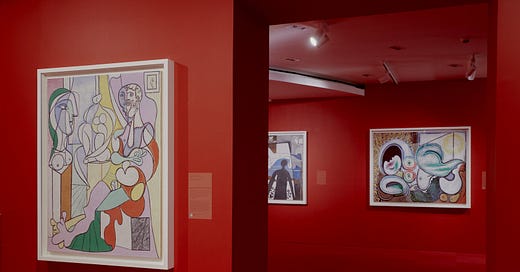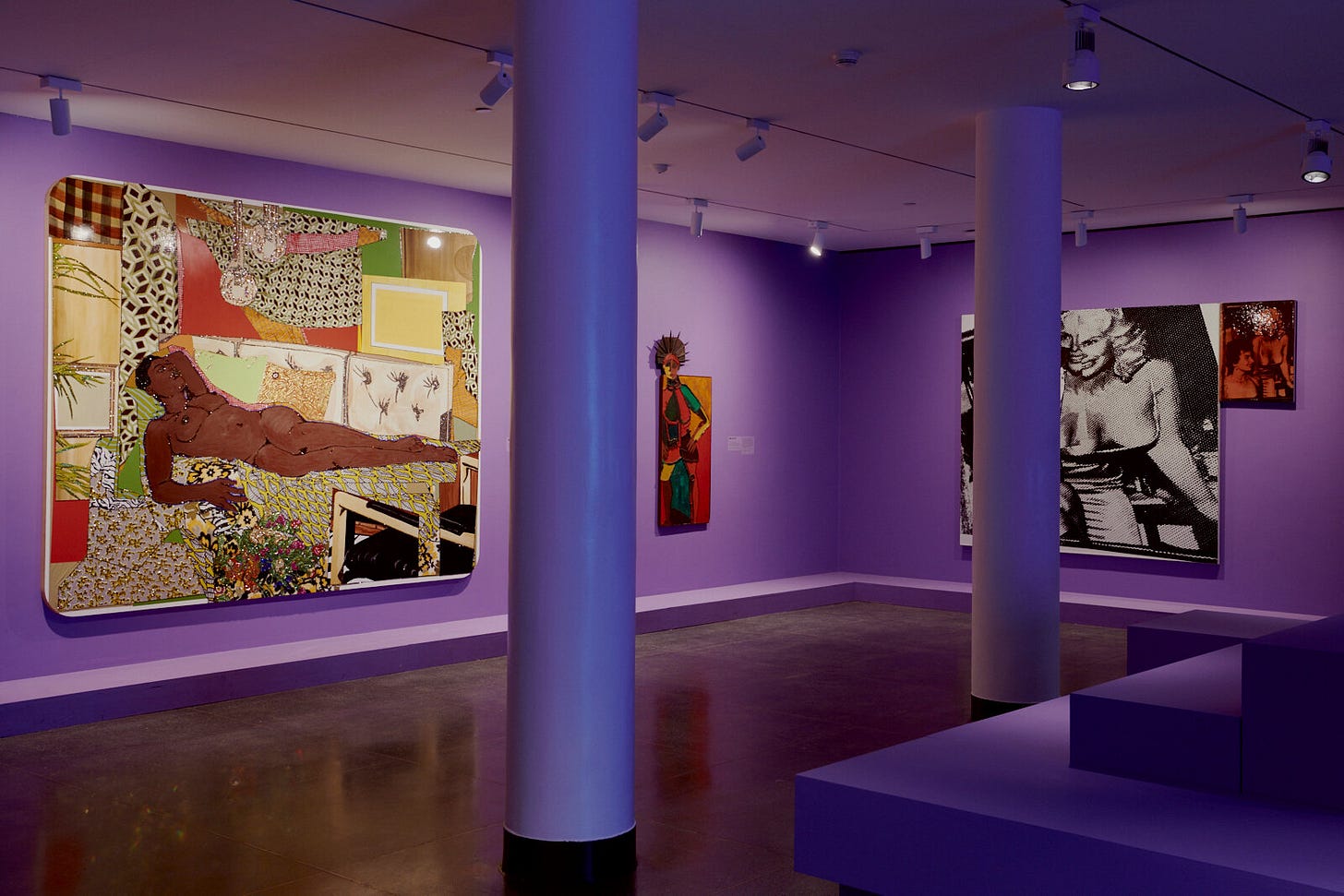“Can it be?” messaged a friend, with a link to Jason Farago’s June 1 review in the New York Times of “It’s Pablo-Matic,” the Brooklyn Museum’s hit job on Picasso. Farago panned the show. The Times, to her surprise and mine, allowed the review to run.
A whole cast of professional art workers — conservators, designers, guards, technicians — has been roped in to produce “It’s Pablo-matic: Picasso According to Hannah Gadsby,” a small exhibition opening Friday at the Brooklyn Museum. (It is a title so silly that I cannot even type it; I am cutting and pasting.) The show, one of many worldwide timed to the 50th anniversary of the Spanish artist’s death in 1973, is essentially a light amusement following on from “Nanette,” a Netflix special from 2018. In that routine, a sort of blend of stand up and TED Talk, Gadsby riffed on having “barely graduated from an art history degree,” at the bachelor’s level, and attempted a takedown of the Spanish artist: “He’s rotten in the face cavity! I hate Picasso! I hate him!” Now this entertainer has come through the museum doors, but if you thought Gadsby had something to say about Picasso, the joke — the only good joke of the day, in fact — is on you.
Gadsby is a comedian known mostly for beefing with Dave Chapelle.
That was unwise. Chapelle is the greatest comedic talent of our time. Gadsby is as funny as pancreatitis.
I replied to my friend, “Let’s see if Farago has a job next week.” Cancelling Farago would be in character for the woke mob running the Times. I added, “Gotta love the installation shots. Curator: ‘Let’s paint the walls Stripper Nail Polish Red!’”
Farago still has his job. But the Monoculture pressured the Times into airing its views. Robin Pogrebin filed “Hannah Gadsby’s Picasso Show Was Meant to Ignite Debate. And It Did” on June 9.
“There is a level of hysteria — and hostility — in some of the writing that reminds me of the hysteria that surrounded ‘The Dinner Party,’” [Judy] Chicago said, referring to her famous feminist installation from the 1970s, which resides at the Brooklyn Museum.
“There is very little space to critique the great heroes of art history, as if they’re above analysis — this very odd idea that patriarchal attitudes and misogyny do not affect either the worldview or creative production of male artists, and of course they do,” Chicago said. “I celebrate and congratulate the Brooklyn Museum for trying to begin that conversation.”
Similarly, the feminist collective Guerrilla Girls, which also has a work in the show, wrote in an Instagram post: “So many angry, hysterical reviews from male art critics must mean that Pablo-matic @brooklynmuseum is saying something really important.”
Hysteria and hysterical derive from Greek husterikós, “suffering in the uterus.” They are gendered characterizations that certain feminists feel entitled to direct at men, as an act of payback. (When I refer to progressives who don’t know the difference between justice and revenge, this is whom I’m talking about.) The same goes for the idea that male critics are merely being emotional. They imply that there is nothing to the critics’ observations that the Brooklyn Museum has done something clownish. That is not debate or conversation, it’s dismissal. Which means that the latter Times headline is incorrect.
This show wasn’t mounted to ignite debate. It was mounted to humiliate the art, the artist, and most of all, the contemporary admirers of the artist. By painting the walls a shade of red that would look over-the-top in a Vietnamese brothel, the eight Picassos in this exhibition are destined to appear as pale trifles. With show labels like these…
Beside one classicizing print of Picasso and his lover Marie-Thérèse Walter: “I’m so virile my chest hair just exploded.” Beside a reclining nude: “Is she actually reclining? Or has she just been dropped from a great height?”
…the viewer is meant to learn to mock the artist. That the jokes don’t land is part of the humiliation. The museum enlisted Gadsby for her talent for humor no more than the Biden administration enlisted Sam Brinton for his talent for nuclear engineering. The point was to hand over control to a conspicuous counterexample of the straight white man. The appointments come with an implicit instruction from the regime that made them: “Say this is good, or you’re a bad person.” That is, lie to yourself and shame the people around you for not going along.
People who enjoy Picasso will come to the Brooklyn Museum to see eight so-so works by the master, installed unflatteringly. Signage will inform the viewer that the artist’s manner of living nullifies his achievements. The exhibition will then lead to artists whom the museum thinks you should admire instead: Mickalene Thomas, Dindga McCannon, and Marilyn Minter, hung on walls painted the color of half and half mixed with grape Fanta. It looks brain-damaged, but at least the reds in the work aren’t disappearing into the background.
Why humiliate the admirers of Picasso? Because the Monoculture is the cultural front of Postliberal Progressive Autocracy. Standing in the way of Postliberal Progressive Autocracy is the West, the liberal order of tolerance, equality, individual rights, and market economics that arose from Enlightenment Europe, coupled with the contemporaneous mores of European Christianity. So the Monoculture denigrates the West through any means it can get away with.
Hence it targets Picasso, who represents a glorious phase of Western art. While postliberal progressivism regards all forms of sex, including gay BDSM puppy scenes, as acceptable and suitable for display to children, it considers a more-powerful white man having sex with a less-powerful woman a crime that taints any art attached to it. It has long been known that Kehinde Wiley and Frances Stark engage in serial power-imbalanced relationships. According to postliberal progressivism, that’s fine, for the same reason that calling men “hysterical” is fine. In Picasso’s case, serial power-imbalanced relationships are the justification for beating his work to death.
The punchline of Pogrebin’s piece - and it’s not Gadsby’s - is that the museum thinks that the problem here is too much courage.
[Lisa] Small, the museum’s senior curator of European Art, said she hopes the strong reactions “don’t prevent visitors from coming to the show and seeing for themselves and also doesn’t have a dampening effect on other institutions that want to take risks.”
You read that right - they think that this self-indulgent revel was an act of risk-taking.
Alas, for all the appeals to comedy, Pogrebin ends on an unintentionally sad note.
[O]thers view the show as a gimmick that should have been avoided. “The museum has better things to do than to make the case for women artists by beating up on Picasso,” the art historian Robert Storr said. “Being anti-Picasso is so easy — it doesn’t get to any of the underlining structural issues. What’s needed is a critique of institutional sexism, not the targeting of one long-dead artist who’s no longer making art.”
It’s a reminder of how liberal progressives think, or used to. But the postliberal progressives don’t want to critique institutional sexism. They want to repurpose it for use against men. Their targeting of Picasso proves it. Storr is as much an affront to their order as I am. So, perhaps, are you.
Content at DMJ is free but paid subscriptions keep it coming. Please consider one for yourself and thank you for reading.
During the week of June 26 we will begin the Asynchonous Studio Book Club reading of Anne Truitt’s Yield. Obtain your copy soon. I have mine, it looks really nice.






This show reminds me of another one I saw in the early 90s, one that reproduced a famous show ftom the 1930s designed to denigrate the artists and modernism in general... The museum replicated the general presentation, including translations of the snarky title cards next the art from the original show... What was that one called? Oh yes: Degenerate Art.
It was an exhibition put together in Germany as a form of Nazi propaganda, intended to show the public dangers of modernism and free thinking. It was designed specifically to point out "qualities such as "decadence", "weakness of character","mental disease", and "racial impurity." It's hard not see plenty of painful similarities between that one of this, though the 1937 show displayed some 1500 works instead of the rather paltry number in Brooklyn. In both shows jokes and cynical comments were included next to each piece, again, as if they were afraid the public might draw their own "incorrect" conclusions on their own.
It's ironic that Picasso, who was always fashionably leftist and officially communist (though that had practically nothing to do with his actual life) is now a whipping boy for "progressives." I suppose his politics are no longer useful, or much less useful than his repurposed role. Funny how that works.